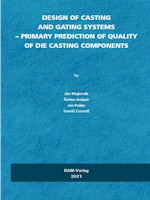|

Monitoring and Analysis of Manufacturing Processes in Automotive |
Abstract
The monograph points out a current state of knowledge in the sphere of production technology of castings by die casting and in chronological or-der it describes die casting technology of metals as well as the die casting machines utilized within the frame of the technology. The cornerstone of the monograph is devoted to description of die casting moulds. The au-thors focused on structure of die casting mouldswith the stress laid on the projection of castings and gating systems. Fundamentals of hydrodynam-ics of molten metal flow in the mould cavity along with basic and structur-al parts of the moulds as well as production process and launching the moulds into production are analysed in detail. Emphasize is also put on clarification of regularities and aspects of suitability and of manufactura-bility of die casting component parts and of projection of gating systems. Based on the results of the selected experiments realized by the team of authors, the analysis of influence of structural modifications of the respec-tive parts of the gating system on quality of castings was carried out with regards to elimination of gas entrapment in the molten metal volume which, as the monograph presents, directly affects the quality of casting properties. The results of the experiments realized under operating condi-tions as well as of those performed by means of simulation software sup-port and move towards recommendations for industrial practice from the point of view of achieving the maximum level of effectiveness and quality of production of aluminium castings through die casting technology. The monograph is intended mainly for students, postgraduates and pedagogues at technical universities as well as to for broad scientific and expert public and technologists and foundry shop workers.
Key words: die casting, projection of castings, projection of gating systems, structure of molten metal die casting, quantitative properties of castings
Introduction
Die casting represents the method of precise casting and approaches the ideal effort to change basic material into a final product. Castings produced in die casting process are characterized by rather high preciseness, smooth surface, thin walls, and positive mechanical properties. At the same time, the castings produced in die casting process it is possible to pre-cast openings of small dimensions, they require negligible sufficient machining, in several cases they represent final products intended for assembly, they correspond with the requirement for replacement of component parts and low weight offers substantial material saving.
Currently, any engineering industry with series production character successfully uses castings produced in die casting process which contain alloys of zinc, aluminium, magnesium, and brass. Automotive or aviation industry utilizes die casting as a sole method assuring economic die casting of high amount of quality castings.
Mechanical properties of castings are closely related to their inner structure, especially to content and distribution of pores and cavities in the volume of castings and, naturally, to the material structure. The monograph presents this issue as a serious drawback of castings and therefore it contains knowledge verified by industrial practice for the purpose of presentation of methods oriented towards reduction and elimination of defects caused by a design of component parts produced in die casting process. The experimental part presents selected experiments confirming by visual demonstration the knowledge and the recommendations included in the theoretical part. A series of experiments was carried out which point out influence of an ingate and of the sprues on mechanical and structural properties of castings with regards to gas entrapment in the molten metal volume and further distribution to the casting.
Endeavour of the authors is to publish a monograph fully describing the issue of designing and constructing of castings along with appertaining gating systems to assure manufacturability of projected parts and defect-free operation of foundry processes in foundry plants.
Methodical Procedure of Publication
Theoretical foundations in the sphere of die casting are on high level. The WoS and Scopus databases offer several publications dealing with the issue. Prevailing part of publications is devoted to technology as such and revolves around the influence of technological parameters on quality of castings. Therefore, the authors decided to publish this monograph solving the issue of design of castings and gating systems in detail.
The authors of the monograph have been experienced in the field of foundry industry with the focus of activity aimed at die casting for many years. Their research work has been revolving around the issue of influence of technological parameters, design of structural nodes of gating systems and their correlations in relation to final quality of castings. Although the publication specializes in the area of production technology in foundry industry, without proper knowledge and information on technology of foundry process the structure itself would not bring desired result.
The information summed up in the publication reflect the knowledge of designing the die casting parts which the authors gathered when dealing with national and international grants and projects as well as by means of solving production issues in the foundry plants.
